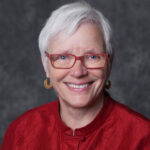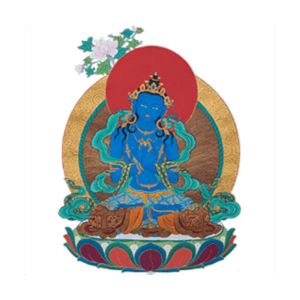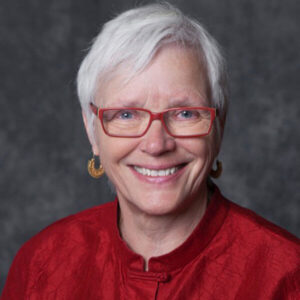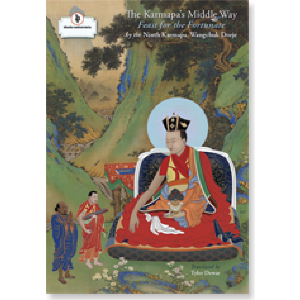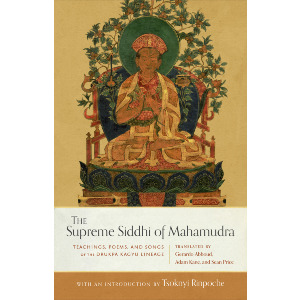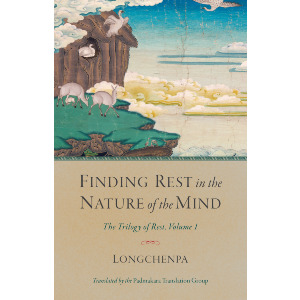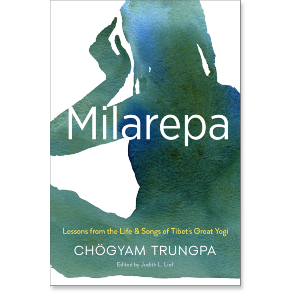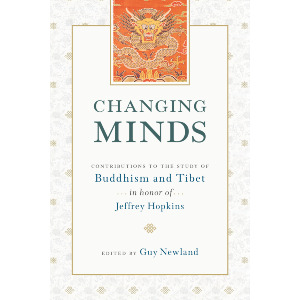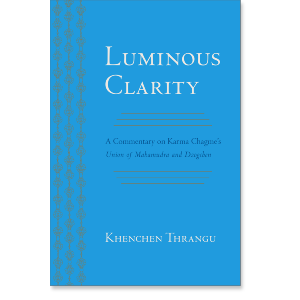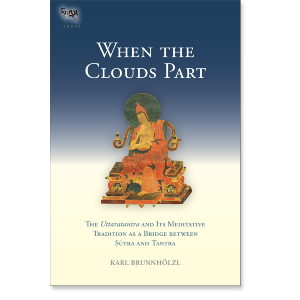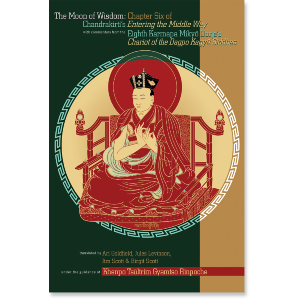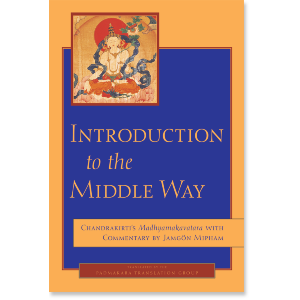The Eighth Situpa Tenpa'i Nyinchay on the
Third Gyalwa Karmapa Rangjung Dorje's
"Aspiration Prayer of Mahāmudrā of Definitive Meaning"
| The following article is from the Spring, 1995 issue of the Snow Lion Newsletter and is for historical reference only. You can see this in context of the original newsletter here. |
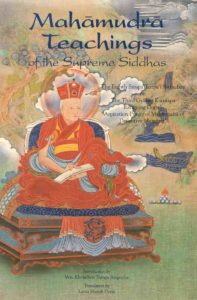
by The Eight Situpa & H.H. the Third Gyalwa Karmapa
Introduction by Trangu Rinpoche
Translated & edited by Lama Sherab Dorje
The following section has been chosen to introduce you to this teaching. It is entitled:
"Aspiration for Prajna That Understands the Path"
Study of scripture and reasoning delivers one from the pall of neoscience.
Reflection on the oral instructions vanquishes the darkness of uncertainty.
The light cast by meditation vividly illuminates the enduring condition.
May the radiance of the three prajnas intensify.
The first line of this verse concerns prajna that arises from study; the second, prajna that arises from reflection; the third, from meditation; and the fourth is a condensed version of the [three] aspiration prayers.
Prajna That Arises from Study
As to the first: in this instance, of the two scriptural sources, dictates and treatises, dictates are, from "Higher Continuum":
Whatever is wholly concerned with meaningful dharmas, is spoken to abolish the rampant afflictive mentalities of the three realms, and instructs in the advantages of peace is the speech of the Sage. Anything contrary is otherwise.
This means all sublime speech that arises based upon the [teachings of the] perfect Buddha, who is the primary condition. If one classifies these there are three: dictates spoken by the Buddha, those spoken with his express approval and those occurring through his blessing. Or else, in terms of their actual content, vinaya, sutra and abhidharma. In that case, one may wonder whether the basket of Secret Mantra is included within any of these three. In fact, since it is the heart of all three, though one may refer to it as the basket of the vidyadharas simply to draw a distinction, it is definitely included. Rangjung Gyalwa says, "through the profound sutra, vinaya and abhidharma," and the "Vajra Heart Commentary" says that "a fourth and a fifth for buddhahood are not the intention of the Sage."
Treatises are, as stated in "Higher Continuum":
Whatever is solely influenced by the doctrine of the Victor; is composed by a totally undistracted intellect and is in accord with the path for attaining liberation, that too raise to the crown of your head like the dictates of the Sage.
These are the entire spectrum of explications of the intent of the Buddhas' dictates which concur with his intended meaning and have been composed by noble bodhisattvas, hearers and ordinary panditas ever since the Teacher exhibited the manner of passing beyond misery in our world. These can be divided into general treatments and specific explications, and in fact there are many other avenues of classification as well.
Reasoning refers to positions, arguments and examples, such as those derived from the textual systems of the "Validity Sutra" and "Series of Seven" and so forth, which are employed in order to reach decisive conclusions, which in turn enable one to understand, in an abstract fashion, the meanings of all things to be realized.
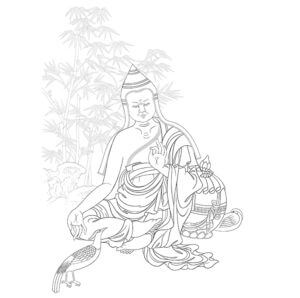
Just as an entire company of blind people is easily guided to its desired destination by a single sighted person, likewise, here, understanding lifts up the sightless qualities and journeys to Victory.
The manner by which this [understanding] realizes the extremely profound dharma is through scripture and also through reasoning; therefore . . .
In "Sequence of Lives":
Learning is a lamp, for it dispels the darkness of bewilderment; the greatest of all wealth, for it cannot be earned off by thieves; like a weapon, for it conquers the enemy, perpetual bafflement; and the best of companions, for it proffers advice on how to proceed.
Prajna That Arises from Reflection
"Oral instructions": in Sanskrit, upadesa. Reflection on the oral instructions means to take to heart and properly reflect upon the meaning of what the Sugatas taught exhaustively, out of loving-kindness, in order to liberate us from bondage to conditioned existence and serenity. In particular, since the Sugatas taught a multiplicity of vehicles to suit individual inclinations, a variety of provisional and definitive teachings emerged, and even more critically, since the tantras of the great secret Vajrayana are totally circumscribed by the six limits and as a result are extremely intricate, one must reflect upon the instructions of an acarya who with completely immaculate dharma vision (prajna), teaching in a manner sensitive to the four maxims, edifies one through properly and fully elucidating the vital issues. Reflecting upon the instructions this way produces the prajna that arises from reflection, and conquers its antithesis, the darkness of ambivalence, which consists of uncertainty about profound issues.
Prajna That Arises from Meditation
By duly reflecting over and over again upon the meaning of what one has studied, one discovers a certitude that is entirely free of ambivalence. Resting equanimously and meditating upon that meaning produces the prajna that arises from meditation, and the glow of that prajna illuminates the essential nature of the enduring condition just as it is.
Enduring condition refers to the nature, or manner of subsistence, of all dharmas, from forms up until omniscience, and is also referred to as ground-state mahamudra, innate suchness, the original Lord, the tathagata potential or tathagatagarbha.
There is both the enduring condition of the entity of the body and the enduring condition of the entity of the mind.
Regarding the former, from Hevajra:
In the great bliss bhaga of the Lady dwells the Teacher with the thirty-two principal attributes and eighty physical signs, in the aspect of vital fluid. Without that, the bliss is lost. Since there is no vitality, the rest follows.
The bliss from deity yoga is not the concrete entity of the Buddha,
nor is it a mere abstraction
That which is formalized in the aspect of face and arms
is the embodiment of supremely unchanging bliss.
Therefore, all beings are connate.
The term "vital fluid" refers to what is produced and appears from conventional bodhicitta, the rarified essence of the channels, winds and drops that is the support for supremely unchanging bliss, which transcends the state of coarse materiality and is therefore of the essence of primordial wisdom. This is the innate body itself. Glorious Rangjung Gyalwa also said this can be called "the enduring condition of the vajra body" since the channels, winds and drops are interdependent, appearing out of the radiance of the mind, and are composed of and appear from conventional bodhicitta, thereby serving as the basis for connate, primordial wisdom.
The seventh Lord described this self-essence lacking the stains of the eight groups and abiding as the four kayas as the evolving potential having no time of inception, and this description appears to coincide and concur with the explanation of Rangjung Doije himself, which can be satisfactorily established through a plethora of scriptural citations and arguments, though for the moment I will not elaborate upon these.
Secondly, the enduring condition of the entity of mind is the dharmadhatu, unrestricted, impartial and free of conceptually constructed limitations. From "Drop of Liberation":
Because it is devoid of all conceptuality,
it is far beyond the realm of the ponderable or expressible.
Like space, it is stainless and the source of everything.
It defies analysis, is the truly profound.
It purifies the spiritual continua of oneself and others,
giving form to mahamudra
that is illusory and like a rainbow,
known as "perfect clarity".
The supreme nature that is the nonduality of these,
the identity pervading all entities, totally unhindered by samsara,
is described as the "dharmadhatu".
That which is explained as nondual profundity and clarity, the innate mind, and the intrinsic, enduring potential is just the same as this.
The meaning of "enduring condition" has here been just touched upon so as not to neglect it entirely, and can otherwise be understood through the explanations that will follow later.
The fundamental, enduring condition of the mind, and of the body, like water and ice, are indivisible, and are therefore called "the union of the two kayas of the ground-state, " which can only be illuminated by unmediated self-disclosive awareness that is capacitated by meditation, and not by any other method. As is said:
This has nothing whatsoever to be removed
and [in] this nothing in the least [need] be installed.
Regard the perfect perfectly.
When perfection is glimpsed,
liberation is total.
The order of progression of the three prajnas is precisely as presented here, and although this may not be definite for those persons who can learn all at once, it is widely known that in the case of gradual learners the stages are interrelated such that without each prior step, its successors will not occur:
Maintaining discipline, with learning and reflection, apply [yourself] fully to meditation.

